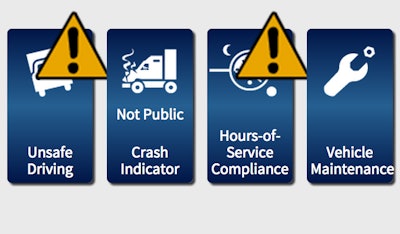
Proposed revisions to the U.S. DOT’s Compliance, Safety, Accountability carrier scoring program — and to how the DOT uses those scores to target carriers deemed at risk for crashes — are being withdrawn, the Federal Motor Carrier Safety Administration announced Friday in a formal notice. The changes, proposed in July 2015 by FMCSA, sought to better align CSA’s Safety Measurement System BASIC scores with carriers’ risk of being involved in a crash.
However, the proposed reforms are being tabled due to ongoing work by the agency to implement a larger overhaul of the CSA program. Spelled out in a Congressionally mandated report last June, the National Academies of Science recommended that the agency rework the SMS and its underlying statistical model.
FMCSA says the reforms proposed in 2015 conflict with the recommendations issued by the NAS report. The NAS report was required by Congress later the same year, when lawmakers also forced FMCSA to remove from public view CSA’s SMS percentile rankings.
The reforms being withdrawn include:
(1) Changes to the so-called intervention thresholds used by the agency to target carriers deemed at risk of a crash;
(2) Segmenting the Hazmat Compliance BASIC (and making it public);

(3) Switching violations for operating while out of service to the Unsafe Driving BASIC (away from whatever BASIC caused the OOS order); and
(4) Increasing the maximum vehicle miles traveled used in the agency’s calculations to more accurately reflect operations of high-utilization carriers.
Under the changes, the interventional threshold in the Vehicle Maintenance BASIC would have been lowered to the 75th percentile from the 80th percentile, meaning potentially more carriers would have been targeted with warning letters, off- or on-site focused or comprehensive audits or other investigations. The intervention threshold in the Controlled Substances BASIC would have been raised to the 90th percentile, thus encompassing fewer fleets. It would have maintained the 65th percentile intervention threshold for the BASICs the agency says have a stronger correlation to crash risk: Unsafe Driving, Crash Indicator and Hours of Service Compliance.
In October 2016, the agency implemented a preview website to show carriers and owner-operators how their scores would have been affected by these changes and other reforms proposed afterward. The agency said Friday it has taken down the preview site.
FMCSA’s proposals sought to institute changes to better the system already in place. However, the 2017 report from the National Academies of Science recommended a major overhaul of the system, starting with the roadside inspection data that feeds the SMS ratings. The report did not go into great depth about how the agency should reconfigure the SMS system, but it did recommend that the agency scrap its current model for determining ratings and opt instead for one based on so-called “item response theory.” An IRT model would more accurately target high-risk carriers, NAS said.
The report also recommended the agency make the scoring system more transparent and easier to understand and to depart from using relative, carrier-to-carrier comparison-based scoring as the sole means for targeting carriers via safety scores.
FMCSA has not provided a timeline for when it will implement the reforms. However, FMCSA Administrator Ray Martinez told Congress in May that the agency has contracted with the NAS and is in the process of developing a reformed CSA program.
Before the NAS issued its report, FMCSA proposed other changes to the CSA system, including raising the minimum number of crashes needed before registering a Crash Indicator BASIC score. The agency in October 2016 issued a proposal to increase that number from two crashes to three crashes. The agency’s Friday announcement did not mention that proposal as one being withdrawn.














